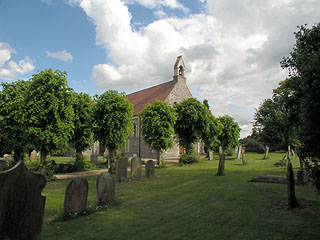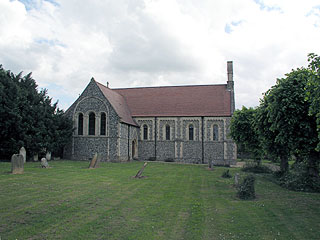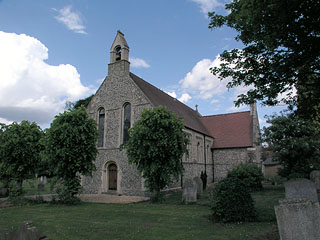The hinterlands between Suffolk and Cambridgeshire are host to many fine, grand churches. Ashley therefore comes as a bit of a surprise. This is a tiny village - little more than a hamlet, really - and St Mary is quite a tiny church. It's also eminently unexciting: a descant on the Victorian idea of Norman architecture.
Moreover, there are two ruined churches in this parish, one belonging to Ashley itself and one to the long-vanished village of Silverley - a state of affairs which struck me as a bit strange.
On the face of it, Ashley ought to have prospered - or at least, not dwindled so much as it has. Too small to be mentioned in Domesday, it grew somewhat over the years. Most importantly, the neighbouring village of Silverley (which was once larger than Ashley) was gradually sucked into its orbit. The parishes were merged in 1554 and Silverley church fell out of use. Thereafter, both settlements grew for a while.
And yet, despite the growing population of two villages to support it, Ashley old church was always a rather pitiful sight. The Cambridgeshire antiquarian William Cole (vicar of Milton) is usually very polite about the county's churches, but he didn't mince his words here:
this is one of the meanest and poorest churches in the whole county of Cambridge. It consists only of a poor small square Tower, if it deserves the name of one, being built of mortar, except the lowest storey which is of stone… the rest of the building consists only of a nave, built of clay…
By the early nineteenth century, the church had fallen into decay (today there's nothing to be seen of it at all) -so much so that the villagers were obliged to worship in a temporary wooden building until the present church was erected in 1845. [Actually, I find out subsequently from local historian Elizabeth Rogers-Ross that it wasn't a temporary structure at all, but rather a very rare example of a fourteenth-century wooden chapel, which was burned down in a fit of ghastly vandalism in the 1950s.] As I stomped around looking at it - and it is, despite the redeeming feature I'll get on to in a minute, a very humble building - I wondered why this parish had fared so badly. There seems no obvious geographical reason for it as the neighbouring parishes - Cheveley, Kirtling, Dullingham and Wood Ditton all seem to have thrived. What went wrong here?
There are a few parishes in the county where the medieval church was completely replaced in the 19th century. Often, the result was disastrous - see poor Wendy, for example. Here, I don't think it was too bad. The main part of the building was erected in 1845 as a simple hall-church in the Norman style. The nave walls are divided into sections by extremely flat buttresses, and within each of these sections a square stone panel contains a round-headed window. It's Norman in inspiration, but it's not a slavish attempt to copy Norman forms, which is nice to see. Sometimes it works - I quite liked the nave walls - and sometimes it doesn't. The west face, for example, is a bit of a jumble. The door is very small, and the space above it is filled with two big round-headed windows where three would probably have looked more balanced.
In 1872, transepts and a chancel were added, which the same whimsical invention. The transepts have big blank arches in their north and south faces, within which the wall is punctuated with three little rounded windows that don't quite match those in the nave. The chancel consists of a rounded apse, and it presses hard against the eastern boundary of the churchyard. Since there seemed no way of getting into the church (and there were no keyholders listed on the board), I went and leaned over the boundary hedge while Mark took a few pictures. The gardens were neat and beautiful - full of bright delphiniums on that early summer's day, and doves cooing in the trees. For all its chequered history, Ashley today seems to be a quiet, content place.
St Mary is kept locked, and there are no keyholders advertised.


